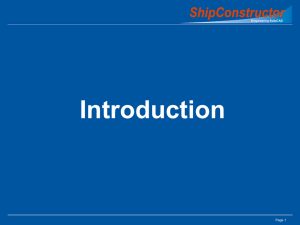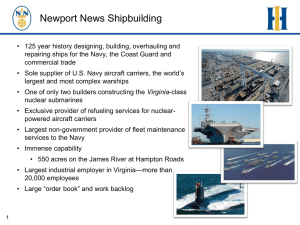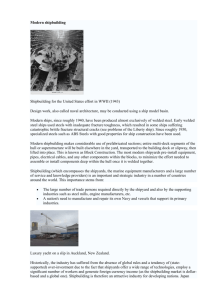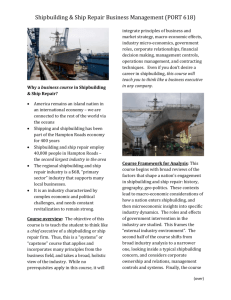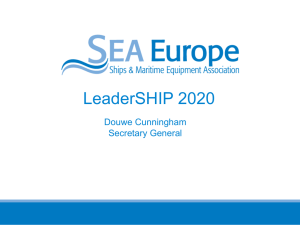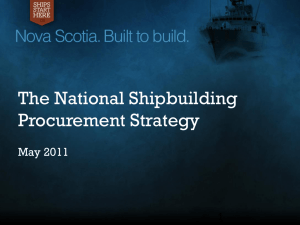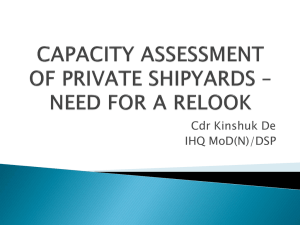WHY CANADA NEEDS A SHIPBUILDING POLICY TOO!
advertisement
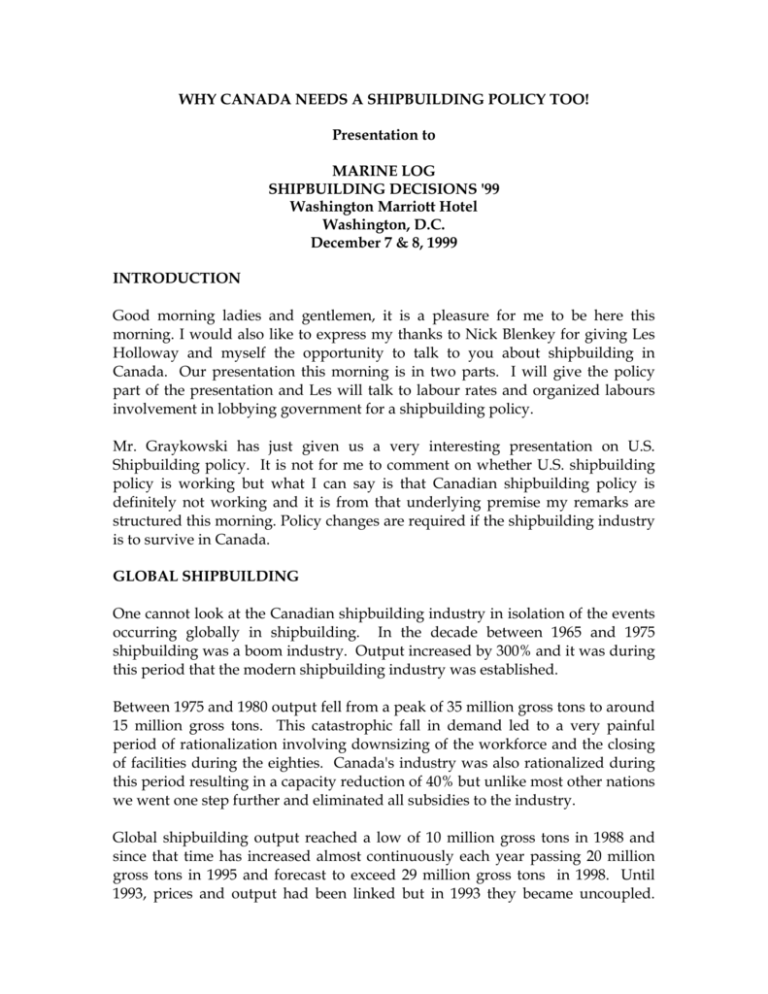
WHY CANADA NEEDS A SHIPBUILDING POLICY TOO! Presentation to MARINE LOG SHIPBUILDING DECISIONS '99 Washington Marriott Hotel Washington, D.C. December 7 & 8, 1999 INTRODUCTION Good morning ladies and gentlemen, it is a pleasure for me to be here this morning. I would also like to express my thanks to Nick Blenkey for giving Les Holloway and myself the opportunity to talk to you about shipbuilding in Canada. Our presentation this morning is in two parts. I will give the policy part of the presentation and Les will talk to labour rates and organized labours involvement in lobbying government for a shipbuilding policy. Mr. Graykowski has just given us a very interesting presentation on U.S. Shipbuilding policy. It is not for me to comment on whether U.S. shipbuilding policy is working but what I can say is that Canadian shipbuilding policy is definitely not working and it is from that underlying premise my remarks are structured this morning. Policy changes are required if the shipbuilding industry is to survive in Canada. GLOBAL SHIPBUILDING One cannot look at the Canadian shipbuilding industry in isolation of the events occurring globally in shipbuilding. In the decade between 1965 and 1975 shipbuilding was a boom industry. Output increased by 300% and it was during this period that the modern shipbuilding industry was established. Between 1975 and 1980 output fell from a peak of 35 million gross tons to around 15 million gross tons. This catastrophic fall in demand led to a very painful period of rationalization involving downsizing of the workforce and the closing of facilities during the eighties. Canada's industry was also rationalized during this period resulting in a capacity reduction of 40% but unlike most other nations we went one step further and eliminated all subsidies to the industry. Global shipbuilding output reached a low of 10 million gross tons in 1988 and since that time has increased almost continuously each year passing 20 million gross tons in 1995 and forecast to exceed 29 million gross tons in 1998. Until 1993, prices and output had been linked but in 1993 they became uncoupled. Although volume has steadily increased since 1993, prices have remained steady and in point of fact have fallen in the past 12 months. The cause of this is South Korea. Between 1987 and 1998, South Korea has increased its building capacity from some 9 million deadweight tons to around 27 million deadweight tons. The majority of this new capacity came online in 1993 and 1994. Most of the increase in world demand that could have contributed to increased prices was soaked up by volume hungry Korean yards who have maintained prices at low levels. One could make a strong argument that this three fold increase in capacity was a Korean government condoned strategy to dominate global shipbuilding at whatever cost. One could also argue that it was in the strategic interest of the west during the cold war to have strong economies in both Korea and Japan and the domination of the market in shipbuilding by these nations, if not encouraged was condoned by western nations. The Asian financial crisis has added fuel to the shipbuilding fire. European shipbuilders have become incensed with what they allege is misuse of International monetary fund money to bail-out Korean shipyards that by western standards would have been forced to declare bankruptcy. Korean shipyards are also accused of dumping cheap ships on the market with no regard for profit. The Koreans, of course, deny the charges. Marine Log reported on October 15, 1999 that the Koreans are building ships at less than cost. This would explain why a ship purchased in Korea today costs 20% less than it did one year ago. The volatility of the industry has put several of the world's largest shipbuilders are on the verge of bankruptcy. Daewoo is dismembering its empire in order to stay afloat and Kvaerner has decided to abandon the shipbuilding business altogether. THE ISSUE OF SUBSIDIES Global shipbuilding is a subsidized industry. Free market forces do not yet dominate. Shipbuilders the world over have been crying out for a level playing field but as we speak shipbuilding nations are considering even more restrictive trade practices. A review of assistance measures being contemplated or enacted to date in 1999 shows that the Norwegian government has increased their direct subsidy from seven to nine per cent and in response to labour pressure is planning a series of government newbuilding orders to assist their industry. The Netherlands has reported that financial support for their shipbuilding sector will be raised in 1999 and 2000. Germany will continue their ship-share tax credit scheme until 2001. They have also approved the use of state export credit guarantees to finance warship sales to South Africa and a development aid loan to the Philippines which will result in an order to a German yard for coastguard vessels. The European Commission will allow Spain to spend $US 186.5 million annually to help its shipbuilding industry survive increased international competition. The British government has announced the extension of the Home Shipbuilding Credit Guarantee scheme that provides finance for merchant vessels built in British yards. They have also decided to extend aid, via the UK intervention fund, to ship conversion projects in addition to newbuildings. The Australian government has decided to extend its newbuilding subsidy to the end of the year 2000. The Russian government is considering loan guarantees for the construction of vessels in Russian yards. It is proposing that shipbuilding firms pay no taxes during the period the loans are being repaid. In the Ukraine, a law is being introduced that will establish a special economic zone around their shipyards. Yards within the zone would get special tax privileges. In India, shipbuilders have requested their government increase the existing 30% subsidy by a further ten per cent. Even china is considering further tax exemptions and export subsidies for its shipbuilding industry. Earlier this year the tax rebate for ship exporters was raised from nine per cent to 14%. ASSISTANCE IN THE UNITED STATES Shipbuilders in the United States do not receive direct subsidies but do benefit from several assistance programs. The best known is Title XI financing which is the envy of most nations including Canada. It was expanded by President Clinton in 1993 to guarantee obligations issued to finance the construction, reconstruction or reconditioning of eligible export vessels. It also authorized guarantees for shipyard modernisation and improvement. Other assistance measures include the Capital Construction Fund, Maritime Security Program and MARITECH ASE program. Perhaps the most notorious assistance measure is the Jones Act. This protectionist legislation has been the subject of considerable debate in the last few years. Our view as Canadian shipbuilders is that the Jones Act constitutes a violation of the intent and spirit of the North American Free Trade Agreement. SHIPBUILDING IN CANADA Canada fronts on three oceans, has the longest coastline in the world and is charged with maritime responsibilities extending over an ocean area greater than its landmass. The St. Lawrence seaway system which provides a transportation waterway to the interior of both our countries is longer than the Atlantic ocean is wide. The origins of shipbuilding in Canada can be traced back to the early 1600s. Shipbuilding reached its zenith during the Second World War when shipbuilders employed 65,000 people and produced 800 naval and merchant vessels over a five-year period. By 1990, at the height of the Navy's Patrol Frigate Program, employment in the industry had fallen to 12,000 and today that figure has been further reduced to only 5,000. In the early to mid-eighties, the Canadian government put in place a three pronged policy for the industry. The three elements of this policy were: - The continuation of tariff protection of 25% on most vessels imported into Canada. This tariff was designed to provide some protection for Canadian shipbuilders from subsidized foreign competitors. The tariff is still in effect except that with the advent of the North American Free Trade Agreement (NAFTA), ships originating in NAFTA countries are exempt; - The procurement from Canadian yards of federal government military and civil shipbuilding requirements. It is from this base that the industry can make the investments in technology that it can use as leverage into other markets. Historically, government fleet renewal has been either a feast or famine and we are in a season of famine. It is our view that a modest investment by government in its fleets on a more continuous basis would provide several advantages. The industry would benefit from more stable workforces and revenues. Government cash flow problems would be eased, more Canadians would be working and the government fleets would be more modern and more economical to operate. This could be done at no increased overall cost to government. Unfortunately, the government has set aside this policy on several occasions and has purchased used vessels offshore under the guise of budgetary restraint; and - The provision of assistance on a cost shared basis for an industry-led rationalization and restructuring. This element of the policy is complete and resulted in a 40% reduction in capacity. Three other elements comprise what the federal government calls a generous package of assistance measures. These are: - Canadian owners can take advantage of accelerated depreciation on Canadian built ships; - Export Development Corporation (EDC) financing is available for commercially based transactions for export. EDC is limited by their mandate and cannot offer terms that are outside the limits stipulated by the Organization for Economic Cooperation and Development (OECD); and - A Research and Development (R&D) tax credit system which is available to all industries not just shipbuilding and has historically been difficult to access and unresponsive to maritime industry needs. The Canadian shipbuilding industry, 'realizing the Lord helps those who help themselves', has done much to make itself more competitive in the last ten years. We produce a quality product. The Navy's new frigate is a glowing testimony to the industry's ability to build an innovative ship on the leading edge of technology. Several of our yards have world class facilities for modern efficient ship construction. Since 1986, private money in excess of $20 million has been invested in Port Weller Drydock. Last year an automated panel production line, a robotic profile cutting line and a robotic welding line were installed in the steel preparation shop. At Halifax shipyards, the Irving Group has invested more than $23 million in capital improvements since 1994. New contracts incorporating more flexible labour practices are the norm and the workforce is highly skilled. Canadian chargeout rates are competitive. In some of the other criteria that impact on competitiveness such as price, quality, dependability, technical capability and modern management and planning we are well placed. We lack principally in the area of financing. Presently there are 26 ships being constructed for Canadian interests. Ten of those are being built in Canada and 16 offshore. Of those being built offshore, four are too large to be constructed in Canada. The remaining 12 could conceivably have been built in Canada. The problem narrows down to what needs to be done to convince those owners to build in Canada. What are the prospects for the Canadian market? There are 174 self- propelled vessels (greater than 1000 grt) in the Canadian registered merchant fleet. In addition there are 253 tugs and 1,312 barges. Some of these vessels will be replaced in Canada. There are no new Navy contracts in the near future but an outside chance of some Coast Guard construction. Great Lakes operators are in the process of upgrading their fleets by conversion not by building. Domestic tankers will require to be double-hulled by the year 2010. One should note that beyond the work that is presently under contract the order books are empty. There are several other issues that complicate the problem. The Jones Act and NAFTA negatively impact Canadian shipbuilders. The United States and Canada are each others largest trading partners. Bilateral trade between our two countries is calculated as $US 312 billion. This has led proponents of free trade to declare that NAFTA works. While NAFTA has positively affected millions of people it has had little positive effect on Canada's shipbuilding industry. The Jones Act was excluded from NAFTA and on January 1, 1998 all other tariffs on shipbuilding and shiprepair disappeared. We are now faced with the ludicrous situation where a company like Secunda Marine can build an offshore supply and anchor handling vessel at Halter Marine, take advantage of Title XI financing and then import it for use in the Canadian coastal trade duty free. It is our industry's belief that protectionist measures like these should not exist between nations that espouse free trade. In an attempt to level the global playing field the Organization for Economic Cooperation and Development (OECD)' after years of negotiations, produced an agreement to prohibit direct and indirect subsidies. Common practices such as export subsidies, loan guarantees, government equity in shipyards, government provision of discounted goods and services and home build requirements would be prohibited. The agreement was scheduled to enter into force in 1996. The decision by the United States, one of the key players behind this initiative, not to ratify it has put the success of any future agreement in doubt. Our industry believes that the elimination of subsidies and unfair trade practices are essential if shipbuilding is to survive in Europe and North America. Indifference and apathy by our federal politicians and officials is a difficult obstacle to surmount. One is left with the impression that our government views shipbuilding as an industry of the last century. Shipbuilding is not seen as a high technology industry worthy of a Canada of the 21st century. These stereotypes are hard to overcome and much of our effort is devoted to this issue. A STRATEGY FOR THE FUTURE What are we doing to advance the cause of shipbuilding. What is fundamentally clear in Canada is that the present industry is unlikely to survive unless it can compete for export contracts. A comprehensive advocacy plan has been underway now for some time. Earlier this year the Shipbuilding Association joined forces with organized labour. In partnership with the Marine Workers Federation/CAW-Canada, the Federation de la Metallurgie Inc., CSN and the Shipyard General Workers' Federation of British Columbia a joint strategy document was produced and sent to the federal government proposing initiatives designed to assist the industry. In this document seven initiatives were put forward for the government's consideration. I will speak to four of these Les Holloway will speak to the remainder. (a) Provision of an export financing and loan guarantee program similar to the Title XI program in the U.S.A. (b) Exclusion of new construction ships built in Canadian shipyards from the present Revenue Canada Leasing Regulations. The regulations as presently stipulated make the ownership and lease financing of a Canadian constructed vessel unattractive if not economical. This exclusion would not eliminate any tax on ships or their owners but would allow the existing depreciation rates applicable to ships to apply without restriction. This not a precedent- setting initiative as significant items of capital equipment are already exempt from the specified leasing regulations. (c) Provision of a refundable tax credit to Canadian shipbuilders. This credit can be considered as an extension of the existing R&D tax credit in Canada, so as to reflect the particular nature of shipbuilding - in which the first units of a new construction or refit program encounter very heavy development costs. (d) Eliminate the one-sided aspects of NAFTA. BENEFITS OF A HEALTHY INDUSTRY The most significant benefit relates to jobs, particularly in regions where well paying highly skilled jobs are scarce. Approximately 6,000 direct jobs would be created with full order books given the present shipbuilding infrastructure. Shipbuilding jobs in Canada produce an average sectoral wage that is 33% more than the Canadian norm. On average, 80% of the construction fee paid to a shipbuilder stays in Canada. Another important reason for maintaining a Canadian shipbuilding industry is that the perishable high-technology skills associated with modern ship construction will remain and continue to grow in Canada. Loss of these skills also has serious repercussions for the maritime defence of Canada. CONCLUSION In the maritime nation called Canada there is a role for the Canadian shipbuilding industry but in order for it to survive it must have access to the world's markets. As the 21st century unfolds, Canada will still have the need of ships. There is an offshore oil and gas industry in its infancy that will have to be supported. There is no reason why Canadian industry should not play a major role in these enterprises. We have no desire to force Canadian shipowners to build in Canada. Our industry wants to compete on its own merit but we cannot get there from here without federal government support. Sir Robert Atkinson, former chairman of British shipbuilding has recently presented a paper on the demise of British shipbuilding which in the last 50 years has seen its market share go from 40% to less than 1.4%. His key point was that, without government support, shipbuilding cannot survive in any country. Shipbuilding is a political issue pure and simple. That, in a nutshell, is why Canada needs a shipbuilding policy too. VICE ADMIRAL PETER W. CAIRNS RCN (RET'D) PRESIDENT, SHIPBUILDING ASSOCIATION OF CANADA Peter Cairns entered Canada's Navy in 1956 where he spent a full career serving at sea and ashore in positions of increasing responsibility. His senior appointments have included posts in National Defence Headquarters, NATO and Command of Canada's Maritime Forces Pacific. He retired in 1994 in the rank of Vice Admiral after spending two years as Commander of Canada's Navy. Subsequently he joined SPAR Aerospace, Aviation Services Division, as Director Business Development. On March 1, 1997 he accepted the position of President as the Shipbuilding Association of Canada. The Shipbuilding Association is dedicated to the promotion and development of the Canadian shipbuilding, shiprepair and associated marine equipment and service industries.

